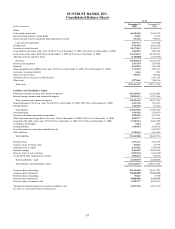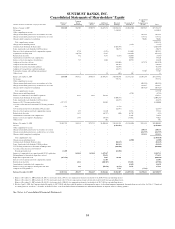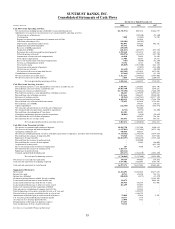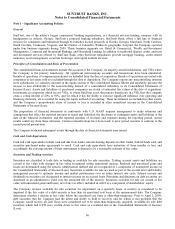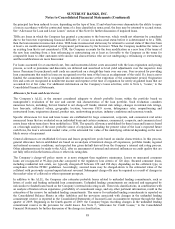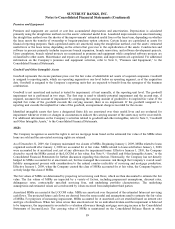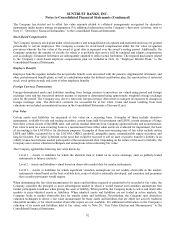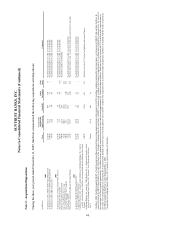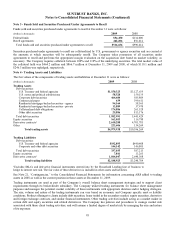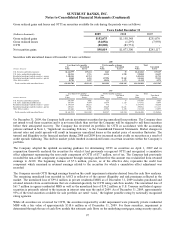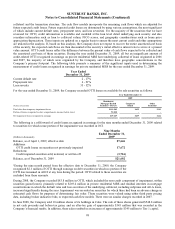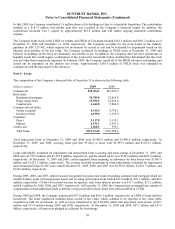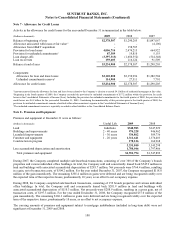SunTrust 2009 Annual Report Download - page 107
Download and view the complete annual report
Please find page 107 of the 2009 SunTrust annual report below. You can navigate through the pages in the report by either clicking on the pages listed below, or by using the keyword search tool below to find specific information within the annual report.SUNTRUST BANKS, INC.
Notes to Consolidated Financial Statements (Continued)
Accordingly, the Company calculated net income available to common shareholders pursuant to the two-class method,
whereby net income is allocated between common shareholders and participating securities. In periods of net loss, no
allocation is made to participating securities as they are not contractually required to fund net losses.
Net income available to common shareholders represents net income/(loss) after preferred stock dividends, accretion of the
discount on preferred stock issuances, income impact of any repurchases of preferred stock, and dividends and allocation of
undistributed earnings to the participating securities. For additional information on the Company’s EPS, refer to Note 13,
“Earnings Per Share,” to the Consolidated Financial Statements.
Guarantees
The Company recognizes a liability at the inception of a guarantee, in an amount equal to the estimated fair value of the
obligation. A guarantee is defined as a contract that contingently requires a company to pay a guaranteed party upon changes
in an underlying asset, liability or equity security of the guaranteed party, or upon failure of a third-party to perform under a
specified agreement. The Company considers the following arrangements to be guarantees: certain asset purchase
agreements, standby letters of credit and financial guarantees, certain indemnification agreements included within third-party
contractual arrangements and certain derivative contracts. For additional information on the Company’s guarantor
obligations, refer to Note 18, “Reinsurance Arrangements and Guarantees,” to the Consolidated Financial Statements.
Derivative Financial Instruments
The Company records all contracts that satisfy the definition of a derivative, at fair value in the Consolidated Balance Sheets.
The Company enters into various derivatives in a dealer capacity to facilitate client transactions and as a risk management
tool. Derivatives entered into in a dealer capacity and those that either do not qualify for, or for which the Company has
elected not to apply, hedge accounting are accounted for as freestanding derivatives. In addition to freestanding derivative
instruments, the Company evaluates contracts such as brokered deposits and short-term debt to determine whether any
embedded derivatives exist and whether any of those embedded derivatives are required to be bifurcated and separately
accounted for as freestanding. If embedded derivatives are not bifurcated, then the entire contract is valued at fair value. In
addition, as a normal part of its operations, the Company enters into certain IRLCs on mortgage loans that are accounted for
as freestanding derivatives. Changes in the fair value of freestanding derivatives are recorded in noninterest income.
Where derivatives have been used in client transactions, the Company generally manages the risk associated with these contracts
within the framework of its VAR approach that monitors total exposure daily and seeks to manage the exposure on an overall
basis. Derivatives are used as a risk management tool to hedge the Company’s exposure to changes in interest rates or other
identified market risks. The Company accounts for some of these derivatives as hedging instruments based on hedge accounting
provisions. The Company prepares written hedge documentation for all derivatives which are designated as (1) a hedge of the
fair value of a recognized asset or liability (fair value hedge) or (2) a hedge of a forecasted transaction, such as, the variability of
cash flows to be received or paid related to a recognized asset or liability (cash flow hedge). The written hedge documentation
includes identification of, among other items, the risk management objective, hedging instrument, hedged item and
methodologies for assessing and measuring hedge effectiveness and ineffectiveness, along with support for management’s
assertion that the hedge will be highly effective. Methodologies related to hedge effectiveness and ineffectiveness are consistent
between similar types of hedge transactions and have included (i) statistical regression analysis of changes in the cash flows of
the actual derivative and a perfectly effective hypothetical derivative, (ii) statistical regression analysis of changes in the fair
values of the actual derivative and the hedged item and (iii) comparison of the critical terms of the hedged item and the hedging
derivative. For designated hedging relationships, the Company performs retrospective and prospective effectiveness testing
using quantitative methods and generally does not assume perfect effectiveness through the matching of critical terms. Changes
in the fair value of a derivative that is highly effective and that has been designated and qualifies as a fair value hedge are
recorded in current period earnings, along with the changes in the fair value of the hedged item that are attributable to the
hedged risk. Changes in the fair value of a derivative that is highly effective and that has been designated and qualifies as a cash
flow hedge are initially recorded in AOCI and reclassified to earnings in the same period that the hedged item impacts earnings;
and any ineffective portion is recorded in current period earnings. Assessments of hedge effectiveness and measurements of
hedge ineffectiveness are performed at least quarterly for ongoing effectiveness. Hedge accounting ceases on transactions that
are no longer deemed effective, or for which the derivative has been terminated or de-designated. For discontinued fair value
hedges where the hedged item remains outstanding, the hedged item would cease to be remeasured at fair value attributable to
changes in the hedged risk and any existing basis adjustment would be recognized as a yield adjustment over the remaining life
of the hedged item. For discontinued cash flow hedges where the hedged transaction remains probable to occur as originally
designated, the unrealized gains and losses recorded in AOCI would be reclassified to earnings in the period when the
previously designated hedged cash flows occur. If the previously designated transaction were no longer probable of occurring,
any unrealized gains and losses in AOCI would be immediately reclassified to earnings.
91




